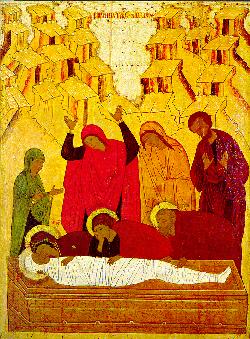
Unidentified School, late 15th century.
Ostroukhov Collection, Tretyakov Gallery, Moscow, 63 x 91 cm.

This is one of the most extraordinary Russian icons. It successfully uses a simple, physical representation to draw attention to the deep, spiritual loss experienced by the figures at Jesus' death. The artist uses this physical medium – the icon – to portray Jesus' physical death, and by doing so he is able to affect the viewer in a very personal way on an individual level. To one degree or another we have all dealt with death and the sense of loss and pain it brings, and in this way we are able to relate to and understand (on a physical, intellectual, and emotional plane) the main drama of the image. The artist recognized this, and used it to remind us of a more pressing, spiritual reality. In The Icon, edited by Kurt Weitzmann, Mikhail Alpatov asserts that "within the context of the whole work, the colors are the vehicle of spiritual expression" (247-8). Indeed, they play important roles not just as sources of expression but as compositional tools used to give emphasis to certain ideas and to create an appropriate ambiance. For example, the colors cascade from lighter to darker tones. Beneath all the figures clothed in fabrics of deep, saturated colors, lies Jesus, wrapped in bright white linen. One's eye is immediately drawn to this spot and, subsequently, to the figures' deep spiritual and emotional responses to his death. This, I believe, is wherein lies half the icon's power – in the depth of feeling shown in the faces of the figures surrounding Jesus (see note below), and in the simplicity with which the image is depicted. As Alpatov states, "every participant is finely characterized by gesture and posture; nevertheless, each is obedient to the austere, measured rhythm as if to a law" (The Icon, 247).
The composition of the work is extremely effective. The mountains in the background do not detract from the main focus of the painting – in fact, they seem to enhance it by providing a geometrical contrast to the less linear bodies below. Though the total of eight figures may be considered an increase in complexity from Kievan times, the icon is still simple and clear. Scholars are not sure which school of icon painting is responsible for the "Entombment," but there are several stylistic tendencies that recognizably derive from the Novgorodian and Muscovite schools. For example, the bright colors,
an increase in the complexity of the composition in comparison to the earlier
Kievan icons, and higher level of expressiveness in the figures, are all characteristic of Novgorodian icon painting. At the same time, the degree of saturation of colors and the overall warmer tones are reminiscent of the Muscovite school. According to Alpatov, in this icon, "the image acquire(s) a profound meaning and a perfection of form to which nothing can be added, from which nothing can be taken away. The artist gives the traditional type a new interpretation " (The Icon, 247). The unity of color, the perfection of composition, and the expressive emotions of the participants
make this icon one of the most impressive works of 15th century Russian art.
(Note: Bending over Christ's body are Mary, John the Theologian, and Joseph of Arimathea; in the next row, standing, Mary Magdalene with outstretched hands, Mary, wife of Clopas, and Nicodemus; one female figure, in green, is difficult to identify). [C.B.]
